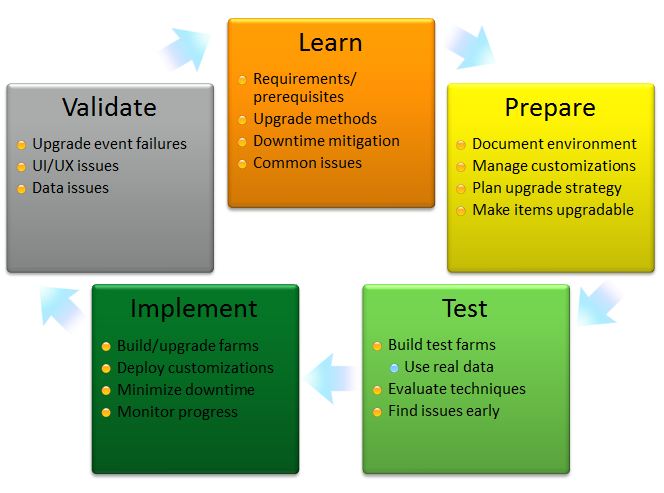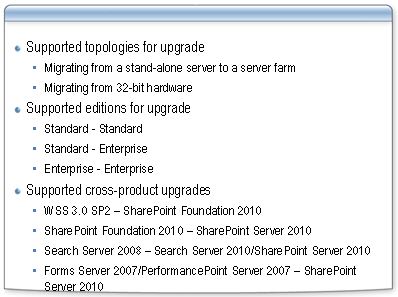SharePoint 2010 Upgrade and Migration summary
Hey SharePoint community,
Once more writting for you a new post about SharePoint 2010 upgrade and migration, since many of our customers are in the middle of this process and several cuestions come up about it, I wrote a summary of the entire process and some additional information you should be aware of, hope this help you in your migration process.
Starting with the diagram below I'll make a summary of the migration activities:
Learn:
- Determine which ones are the pre-requisites for a SharePoint 2010 migration, for example you must have SharePoint Products and Technologies 2007 Service Pack 2 installed
- Preupgradecheck tool to identify possible issues during migration (psconfig -cmd preupgradecheck, ONLY available in SP2)
- Which approach we will choose, Inplace, DB Attach o Hybrid (https://technet.microsoft.com/en-us/library/cc263447.aspx) ? Do I have the hardware or vitual resources to pick Hybrid and minimize downtime?
- Identify common issues in a migration process, for example the new SharePoint 2010 infrastructure is ready for a migration, did I do a Capacity Planning?
- Supported upgrade paths
Prepare:
- Full inventory: Customizations (Master Page, Theme), Site definitios, Templates, Solution packages (wsp), Custom code (Web.Config, GAC. BIN), SPSFarmReport (https://spsfarmreport.codeplex.com/ - small inventory)
- Customization must be tested and approved in a SharePoint 2010 test farm
- Does the migration includes Site Collection, sites, web applications, lists, document library re-organization? Is this a good time to do it?
- Am I using third-party web parts, are they supported in SP 2010, Do I have flash? If I have one or both of them, ask for support to your web part vendors or convert your flahs files to silverlight (Using third-party tools to convert flash files is always an option). Take a look at (https://msdn.microsoft.com/en-us/library/microsoft.sharepoint.webpartpages.silverlightwebpart(office.14).aspx)
- Create a Capacity plan (https://technet.microsoft.com/en-us/library/ff758645.aspx) for the new SharePoint 2010 farm, which SharePoint 2010 services I will provide in my new farm, which others must be off or not deployed
Test:
Once we covered the last 2 steps and double check every objects that belongs to our new SharePoint 2010 farm, we will need a test phase
- Build a new SharePoint 2010 farm, physical or virtual, but use always REAL data for testing (Content Databases backup/restore)
- Evaluate migration migration techniques, example Do I use Central Administration site to attach content databases or I will use PowerShell, both should work, from my point of view PowerShell is better
- Use Test-SPContentDatabase (https://technet.microsoft.com/en-us/library/ff607941.aspx) in order to make sure that content will be upgraded successfully and there are no customizations missing over the new SharePoint 2010 farm
- Attach content databases using Visual Upgrade (-updateuserexperience / https://technet.microsoft.com/en-us/library/ff607813.aspx / https://technet.microsoft.com/en-us/library/ff607581.aspx)
Implement
Now is time to start the real migration
- Based on the Capacity planning we already defined: create the new SharePoint 2010 topology and architecture, virtual or physical servers, if you will use virtual environment please validate which SharePoint 2010 server roles are recommended to be virtualized (https://technet.microsoft.com/en-us/sharepoint/ff602849.aspx; https://technet.microsoft.com/en-us/library/ff621103.aspx)
- Install and deploy all the identified customizations on the Preparation phase
- Once you met all the possible problems during the migration on test phase, downtime will be minimized, you can use AAM Redirection and READ-ONLY databases (https://technet.microsoft.com/en-us/library/ee720448.aspx / https://technet.microsoft.com/en-us/library/dd793608(office.12).aspx)
- Monitor the whole migration process because this can be completely exhausting, therefore create migration groups in your ITPROs team to complete the process using monitoring schedules
Validate
To finish, review all your work is important
- Upgrade, ULS, Error and Event Viewer logs have to be reviewed
- Check all your content surfing over your Site Collections and sites
- Double checking the information is a must, compare the information in your old MOSS 2007 farm against your new SharePoint 2010 farm
Good luck!!!

